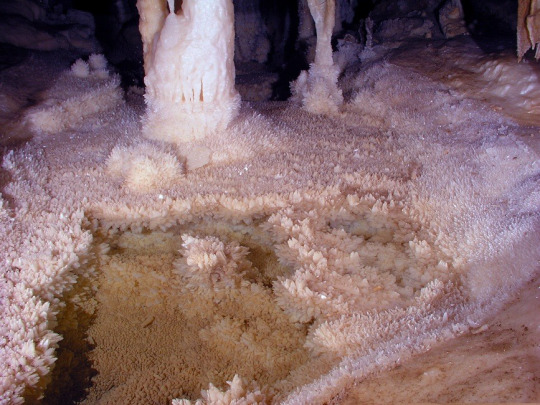denizen at the end of time|17|she/her|audhd
Last active 60 minutes ago
Don't wanna be here? Send us removal request.
Photo

Michael Bohme, “Parallel Worlds”
5K notes
·
View notes
Text

I think the alucardlings want something. not sure what
33 notes
·
View notes
Text

227 notes
·
View notes
Text
every time i listen to this song i start levitating fr

5 notes
·
View notes
Photo

Michael Moorcock, actor Jon Finch (as Jerry Cornelius) and Space Ritual-era Hawkwind (l-r: Dik Mik, Robert Calvert, Nik Turner, Stacia, Simon King, Dave Brock, Del Dettmar, Lemmy) in a deleted scene from The Final Programme (1973), a film by Robert Fuest.
14 notes
·
View notes
Text

7 notes
·
View notes
Text
The Room (2003) Dir. Tommy Wiseau
The Room Messiah (2006) Dir. Tommy Wiseau
Children of the Room (2013) Dir. Tommy Wiseau
God Emperor of the Room (2018) Dir. Tommy Wiseau
Heretics of the Room (2021) Dir. Tommy Wiseau
Chapterhouse: The Room (2022) Dir. Tommy Wiseau
Prelude To the Room (2036) Dir. Brian Wiseau
Legends of the Room (2039) Dir. Brian Wiseau
Hunters of the Room (2043) Dir. Brian Wiseau
Sandworms of the Room (2044) Dir. Brian Wiseau
Paul of the Room (2045) Dir. Brian Wiseau
The Winds of the Room (2046) Dir. Brian Wiseau
Sisterhood of the Room (2049) Dir. Brian Wiseau
Mentats of the Room (2051) Dir. Brian Wiseau
Navigators of the Room (2051) Dir. Brian Wiseau
Princess of the Room (2060) Dir. Brian Wiseau
1K notes
·
View notes
Photo

The romance of modern chemistry, 1909
441 notes
·
View notes
Text




Onondaga
📷: @sjscoyote , 2010
📍: Onondaga Cave State Park, Missouri
1K notes
·
View notes
Photo

1.7.14 An Author’s Journey: 5.5, Sci-Fi Influences (Pt 5: Of Blade Runner, Sand Worms, Tesseracts, Dragons, & Steampunk)
Anne McCaffrey, Dragonquest (Michael Wheelan)
1.7.14 An Author’s Journey: 5.5, Sci-Fi Influences…
View Post
2 notes
·
View notes
Text
““This lake was, of course, Lake Billy the Kid. Lake Billy the Kid was named after the legendary American explorer, astronaut and bon-vivant, who had been crucified around the year 2000 because it was discovered that he possessed the hindquarters of a goat. In Billy the Kid’s time such permutations were apparently not fashionable.””
— Michael Moorcock, “An Alien Heat” (via glamrack)
6 notes
·
View notes
Text
Wet Beast Wednesday: cave fish
Prepare for a deep dive today. Not because I'm going to be more in-depth than usual, but because we're talking about caves. Which are deep. In the ground.... Yeah, you get it. Today is going to be a bit different from my normal WBW posts. Instead of going in depth on a particular species or group of related species I'm going to discuss common adaptations fish evolve to live permanently in caves and then go over a few species I find interesting. Let's get spelunking.
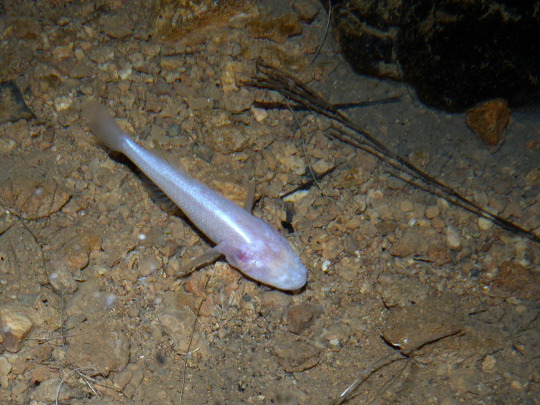
(Image: Typhleotris madagascariensis, a typical cave fish. It is a small fish with an entirely white body and smooth skin where the eyes would be on a normal fish. It is resting on rocky sediment. End ID)
Caves are not an easy place to live. There's no light, limited food, often low oxygen levels, and the threat of collapse or rockfall. Cave-swelling animals (collectively called troglofauna) need a number of special adaptations to survive and there is little room for error. Troglofauna that are strictly aquatic are called stygofauna. Troglofauna and stygofauna can be divided into three groups based on their life history. Troglophiles and stygophiles complete part of their life cycle in caves and part outside of them. A classic example of this is the many species of bat who seasonally inhabit caves to give birth and mate. Trogloxenes and stygoxenes are animals who will visit caves, but do not require time in caves to complete their life cycle. An example trogloxene would be a bear who takes shelter in a cave during winter. Finally, troglobites and stygobites live their entire lives in caves and never leave. The fish I discuss today are stygobites. Because troglobites and stygobites generally will die outside of their caves, they have very little opportunity to disperse. As such, many cave fish species are found only in a single cave or cave system and are entirely dependent on the health of their homes to survive.
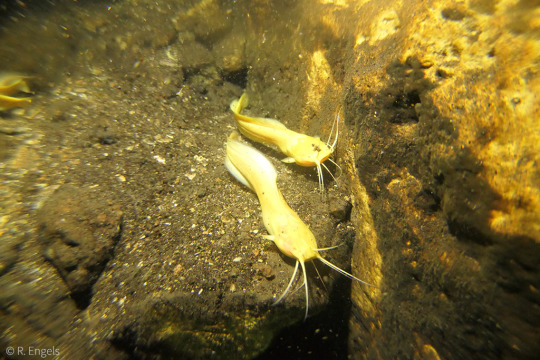
(Image: two cave catfish sitting next to each other on a rock. They are white with elongated anal and rear dorsal fins, and no eyes. End ID)
Many cave-dwelling animals develop a set of common adaptations called troglomorphism. Cave water is often high in minerals but low in oxygen and food content. To survive, the fauna develop very slow metabolisms, allowing them to last a long time on limited resources while slowing down movement and other active systems and increasing age. These species are also typically smaller than their epigean (above-ground) relatives, further reducing their energy requirements. Slowed metabolism results in comparatively slow development. Cave species take much longer to mature and reproduce then related epigean species. Many species further decrease their energy consumption by moving as little as possible. Many species of cave fish are able to last long periods of time between meals without negative impacts to their health. They will binge eat whatever they can find and then subsist on fat stores while food is scarce. One test in captivity showed that a Phreatobius cisternarum (cave catfish) could go a while year between meals and stay healthy. Cave species are usually opportunistic generalists as they can't afford to pass up resources. Much of their food will originate outside of the cave, either directly or indirectly. Water flow into caves brings in algae, bacteria, plankton, and other food sources. Other more indirect methods of introducing include bat feces. While the fish may not eat the feces directly, other species may do so and potentially become prey to the cave fish. The feces also introduces nutrients from outside the cave that encourages the growth of other food sources like bacteria, fungi, and planktonic animals.
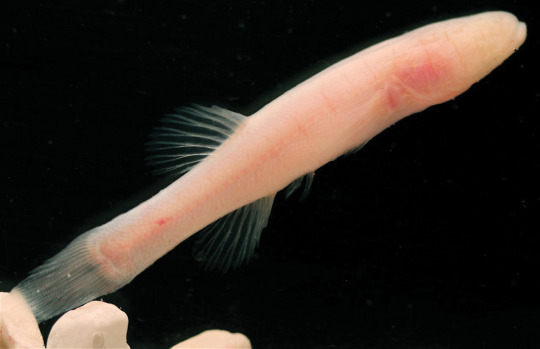
(Image: Amblyopsis hoosieri, the hoosier cave fish. It is a very simplistic fish with no eyes or scales. End ID)
Life in a cave comes with a different sensory requirement. The complete lack of light makes vision useless. You don't know dark until you've seen cave dark. Fun fact: caves are so dark that sighted people can start hallucinating in them because our brains aren't evolved to handle zero visual stimulus and will start making stuff up to fill that gap. As a result of the utter darkness, many species of cave fish are blind. They either evolve to completely lose their eyes or have the eyes considerably reduced in size and function. Eyes take up a lot of energy to maintain and in caves, there is a lot of selective pressure to get rid of organs that aren't useful there. Despite the blindness, many species retain some form of photosensitivity and will flee from light. Cave species also often lack skin pigmentation. Skin pigment has two primary uses. It protects the skin from ultraviolet light in sunlight, and provides skin coloration that can be used for camouflage, displays, warnings, and so on. In an environment where there is no ultraviolet light and everyone is blind, skin pigment serves no real purpose and is lost. As a result, most cave species are white or translucent. The lack of pigment may be a reason so many species remain photosensitive. Without pigment, they would be highly susceptible to sunburn or skin cancer from ultraviolet light. Caves also have a sound dampening effect that makes hearing less valuable. Reduced eyes and pigmentation is also seen in deep sea fish that live too deep for light to reach. Even those species still use visual curs more than cave fish due to the abundance of bioluminescence in the deep ocean.
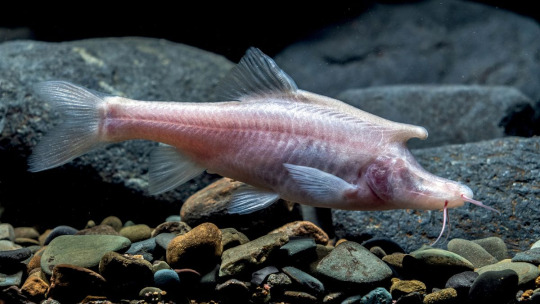
(Image: Sinocyclocheilus longicornus, a recently discovered species. It is a fish with translucent skin, revealing the skeleton. It has a long shout with two pairs of barbels. Emerging from the upper back is a horn-like protrusion. End ID)
With vision off the table, cave fish rely on other senses. chemoreception through taste and smell are strongly selected for as traits that can direct cave animals toward food or away from threats. Another sensory system fish have is the lateral line. The Lateral line is an organ system found on each side of a fish where modified skin cells called hair cells detect motion in the water. The lateral line allows fish to sense movement in the water around them, informing them of water flow and the movement of food and threats. Cave fish typically have a well-developed lateral line system that compensates for the lack of vision. Many fish perform displays for various reasons, such as attracting mates. These displays are typically visual, but in cave fish, that isn't an option. Instead, their displays are more focused on moving the water in ways that can be detected by lateral lines. Some species of cave fish maintain additional sensory abilities from their epigean ancestors. An example of this are cave catfish, who retain the barbels and electroreception common to their kind.
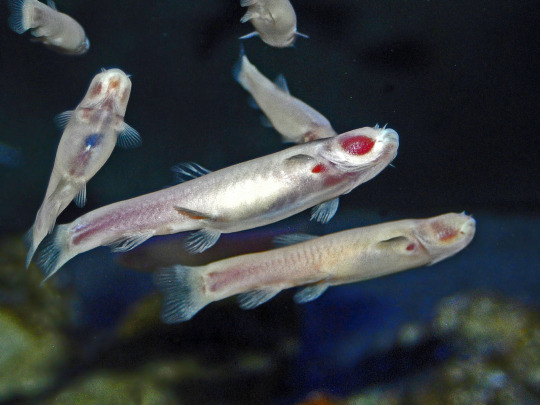
(Image: six Phreatichthys andruzzii. They are long, eyeless, white fish. The blood-filled gills are visible through its translucent skin, seen as a large red patch on the head. End ID)
Before moving on to specific species, it should be noted that cave fish is not a taxonomic category. Cave fish come from many different lines of descent and independently evolved similar adaptations to cave conditions. These similar adaptations are seen in most cave fauna, not just fish, and are collectively called troglomorphism. There are about 300 species of cavefish known to science.
Ophisternon candidum, or the blind cave eel, lives in north Australian caves that are connected to the ocean. Because these caves intake salt water, the pools and streams within them can become very salty, resulting in the eels developing a tolerance to a high range of salinity. They are rare, having been spotted under 40 times since 1959, and thus little is known of their lifestyle. We do know they burrow into sediment and secrete mucus to keep those burrows stable. Males seem to build burrows to woo females. They have been bred in captivity for use un laboratories. At up to 40 cm long, they are huge for cave fish and used to hold the record for the largest species known until another species was found that's even bigger.
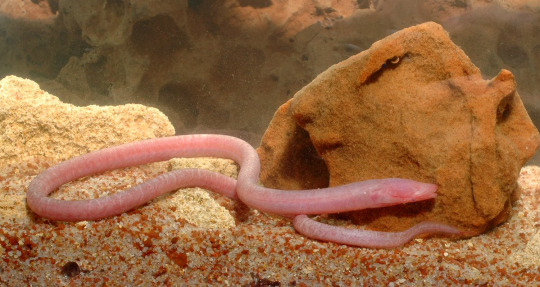
(Image: an eel with translucent, pink skin, no eyes, and ribs visible through the skin. It looks somewhat like an earthworm. End ID)
The actual largest known cave fish is Neolissochilus pnar, which gets up to 40 cm while being more massive than the eel. They are found in a single cave system 100 meters underground in India. The primary food source in the cave appears to be debris from the nearby forest that is washed into the cave during seasonal flooding. The fish may have been known to locals well before it was scientifically described, as there are stories of white cave fish going back over a century in the region.
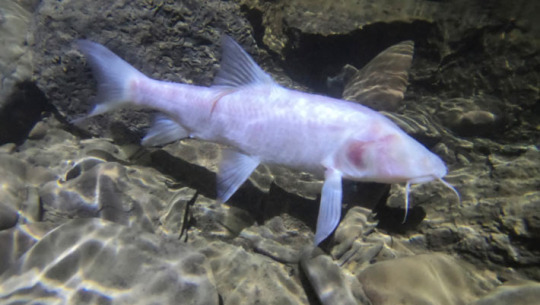
(Image: a small fish with no eyes, white skin, and a long snout with barbels on it)
The Alabama cave fish (Speoplatyrhinus poulsoni) may be the rarest species of freshwater fish in the world. They live exclusively in key cave, Alabama, USA and no more than 10 have ever been seen at a time. The population is estimated to be under 100, below the generally accepted minimum viable population for a species of 200. Fittingly enough, this means a species only found in Alabama may be severely inbred. They are believed to be triggered to mate by seasonal flooding and may be mouth brooders. Climate change-caused changes to flooding and toxins leaking into the groundwater from sewers are currently threatening them with extinction.
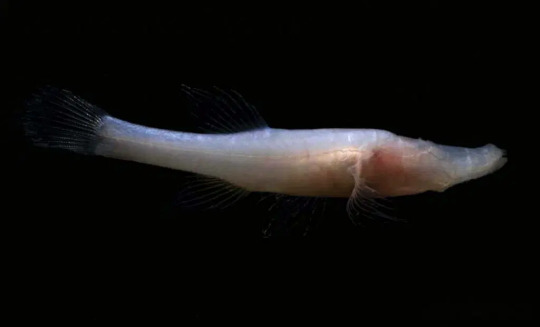
(Image: a long, white, eyeless fish with an elongated snout. Its skeleton is visible through its skin. End ID)
Typhliasina pearsei, the Mexican blind brotula or dama blanca ciega (blind white lady), lives in the cenotes of the Yucatán peninsula. Cenotes are sinkholes filled with groundwater and the ones in the Yucatán are often connected by underground caves, rivers, and aquifers. The fish are apex predators who eat shrimp and mysids and are known to coexist with other cave fish in part of their range. As with other brotulas, they are a rare example of a bony fish that gives live birth. Because of how interconnected and numerous the cenotes are, this species has one of the largest distributions of all cave fish.
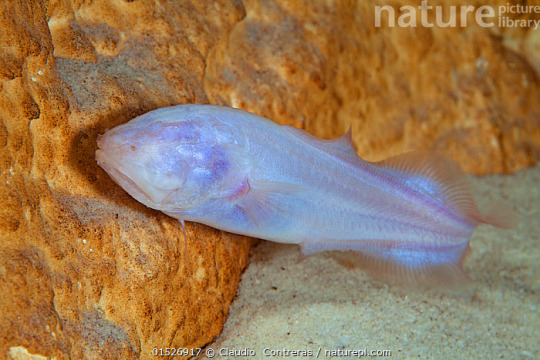
(Image: an eyeless white fish with a long tail and elongated rear dorsal and anal fins. It is next to an orange rock. End ID)
Cryptotora thamicola, the cave angel fish or waterfall climbing cave fish, is the adrenaline junkie of the cave fish world. Most cave fish live in slow-moving or still water, but this daredevil lives in rapids. But just living in rapids isn't extreme enough, these guys climb waterfalls. Their large fins with hooked fin rays let them cling onto the rocks while facing into the current. They then allow food to flow right into their mouths. Unlike other walking fish, the waterfall climbers have a well-developed pelvic girdle and walk in a style very similar to tetrapods, with front and back fins alternating strides. This has made them very interesting to evolutionary biologists studying the transition from fish to tetrapods.
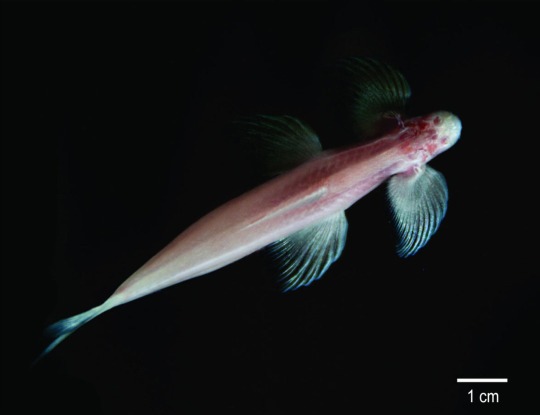
(Image: a typical cave fish with very large pectoral and pelvic fins. End ID)
The Mexican tetra (Astyanax mexicanus) is an example of a handful of fish species that have a cave form and a non-cave form. Most Mexican tetras are perfectly ordinary tetras, but one population has adapted to cave living and has developed trogomorphic traits. The cave from lack pigment, has tastebuds on its head, lacks eyes, and can store more body fat. While you would expect such radical physiological differences to mean the two populations are different species, they aren't. The two populations are fully capable of producing fertile offspring and do so in the wild. If you've ever seen a cave fish in person, there's a good chance it was one of these as the cave form has entered the pet trade and they do very well in captivity, making them the most studied cave fish.
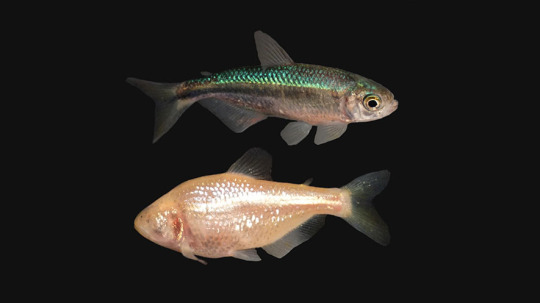
(Image: the non-cave and cave forms of the Mexican tetra seen next to each other for comparison. The non-cave form is a fairly typical silvery-green fish. The cave form is slightly more robust, white, and eyeless. End ID)
Because most cave fish are found only in a singe cave or cave system, they are fully dependent on the health of that cave. Caves tend to be very stable environments, which results in the inhabitants being pretty bad at adapting to change. Changes in water flow, introduction of new species, and pollutants can seriously harm or wipe out whole species. Many species of cave fish are rated as endangered or critically endangered based on their low populations and vulnerability to change.
617 notes
·
View notes
Text
Imagine if Buzzfeed had a "which Eternal Champion are you?" Quiz
For me personally, I think I'd get Jherek
You?
#michael moorcock#Eternal Champion#we have similar stances and interests#elric of melnibone#corum jhaelen irsei#dorian hawkmoon#john daker#erekosë#jerry cornelius
4 notes
·
View notes
Text
youtube
Blue Öyster Cult - Veteran Of The Psychic Wars
6 notes
·
View notes

